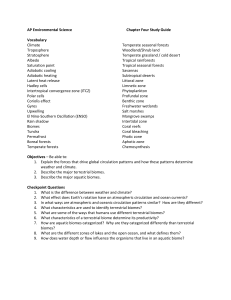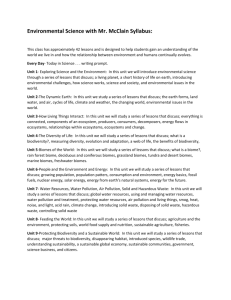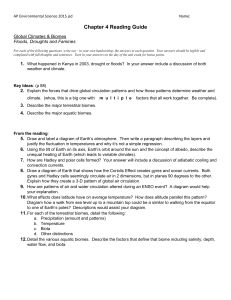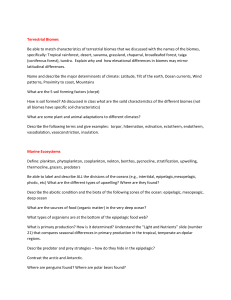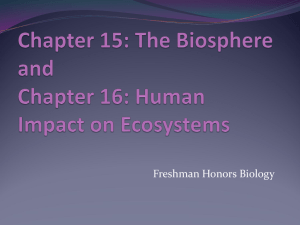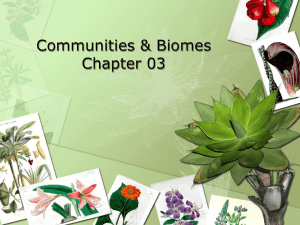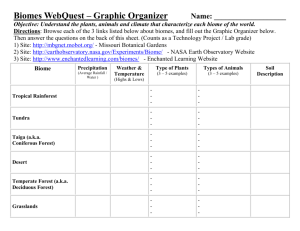Ecology Chapter 1 Section 4: Biomes Learning Targets: Students
advertisement
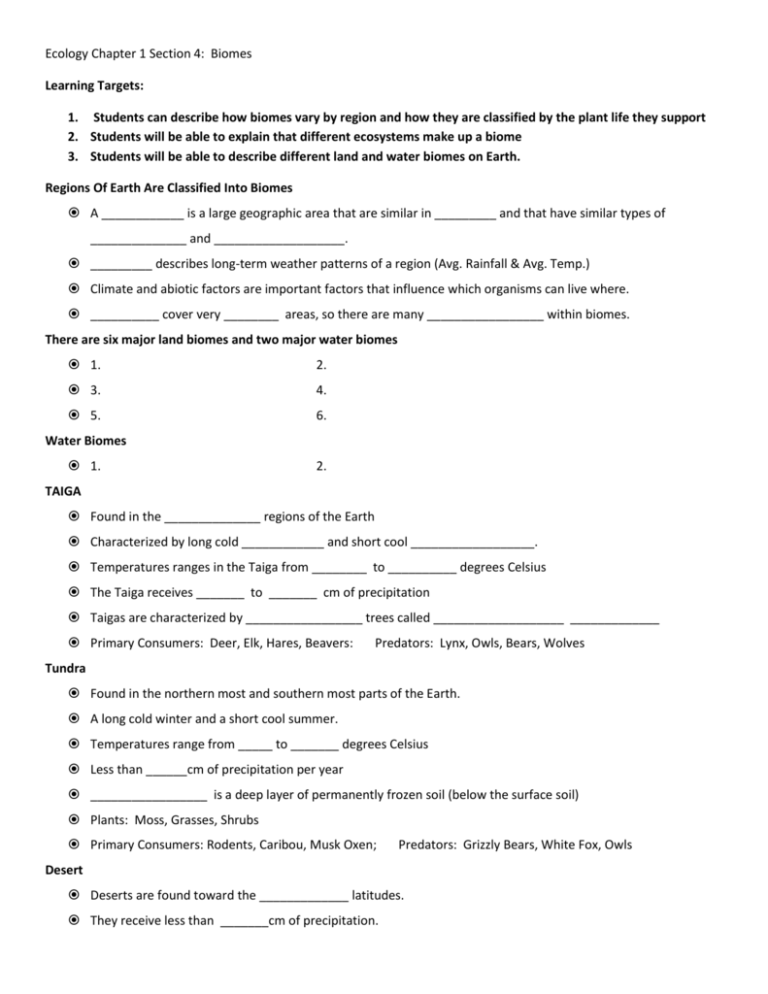
Ecology Chapter 1 Section 4: Biomes Learning Targets: 1. Students can describe how biomes vary by region and how they are classified by the plant life they support 2. Students will be able to explain that different ecosystems make up a biome 3. Students will be able to describe different land and water biomes on Earth. Regions Of Earth Are Classified Into Biomes A ____________ is a large geographic area that are similar in _________ and that have similar types of ______________ and ___________________. _________ describes long-term weather patterns of a region (Avg. Rainfall & Avg. Temp.) Climate and abiotic factors are important factors that influence which organisms can live where. __________ cover very ________ areas, so there are many _________________ within biomes. There are six major land biomes and two major water biomes 1. 2. 3. 4. 5. 6. Water Biomes 1. 2. TAIGA Found in the ______________ regions of the Earth Characterized by long cold ____________ and short cool __________________. Temperatures ranges in the Taiga from ________ to __________ degrees Celsius The Taiga receives _______ to _______ cm of precipitation Taigas are characterized by _________________ trees called ___________________ _____________ Primary Consumers: Deer, Elk, Hares, Beavers: Predators: Lynx, Owls, Bears, Wolves Tundra Found in the northern most and southern most parts of the Earth. A long cold winter and a short cool summer. Temperatures range from _____ to _______ degrees Celsius Less than ______cm of precipitation per year _________________ is a deep layer of permanently frozen soil (below the surface soil) Plants: Moss, Grasses, Shrubs Primary Consumers: Rodents, Caribou, Musk Oxen; Predators: Grizzly Bears, White Fox, Owls Desert Deserts are found toward the _____________ latitudes. They receive less than _______cm of precipitation. The organisms here are able to survive on very little precipitation Producers: Cactus, grass, shrubs; Primary Consumers: Kangaroo Rat, Ground Squirrel Secondary Consumer: Collared Lizard, Scorpion, Snakes, Owls, Foxes Grasslands They receive ______ to _______ cm of rainfall per year There is enough rain to support _____________ but too little to support _________________. Grassland have warm summers, up to _____ degrees Celsius, but cold _____________. Home to some of the largest animals on Earth Primary Consumers: Bison, Wild Horses, Gazelle, Zebra, Elephant; Predators: Wolves, Tigers, Lions, Cheetah Temperate Forests Across the middle latitudes they receive ____ to ______ cm of precipitation per year Most temperate forests are made up of _____________________ _________. _______________________ trees drop their ______________ in the fall and grow news ones in the __________________. Most temperate forests in North America are deciduous However, in the Northwest there are forests made up mostly of ____________________ trees. (Redwood, Spruce, Fir) These are referred to as temperate rain forests. The largest trees in the US are found in these temperate rain forests. Primary Consumers: Mice, Chipmunks, Raccoon, Deer Predators: Bobcats, Foxes, Coyote, Wolves, Mountain Lions Tropical Rain Forest Located near the ______________ where the weather is warm all year around ____ deg. Celsius The tropical rain forest is the__________ land biome receiving _____ to ______ cm of rain yearly The trees tend to have their leaves year round. More types of _____________, ______________, and other organisms live here than anywhere else on Earth Ex. Toucan, Orangutan, Boa Constrictor, Red Eyed Tree Frog Freshwater Biome Freshwater biomes are ______________, ______________, ______________and ____________ An ______________ is where the freshwater of a ______ meets the saltwater of an _________. _______________ and _____________________ are two types of estuaries. Estuaries are sometimes called the nurseries of the sea because so many marine animals travel to reproduce there. Marine Biome ____________biomes are __________________ biomes. The three general marine biomes are main ____________________, _____________________, and ____________________. _______________ are part of the coastal ocean biome. Organisms like ____________ and _____________ thrive in coastal areas. Organisms in the open ocean receive less sunlight and the temperatures are colder. Many types of ___________ other marine animals and floating _______________ live in the upper ocean. There are no __________________ in the open (upper) ocean The deep ocean regions are much _________________ and ______________ than the upper ocean. There is no ____________________ available for ____________________________. The animals here either feed on_____________ other or materials that fall down from upper levels. Home to many bizarre looking creatures.


